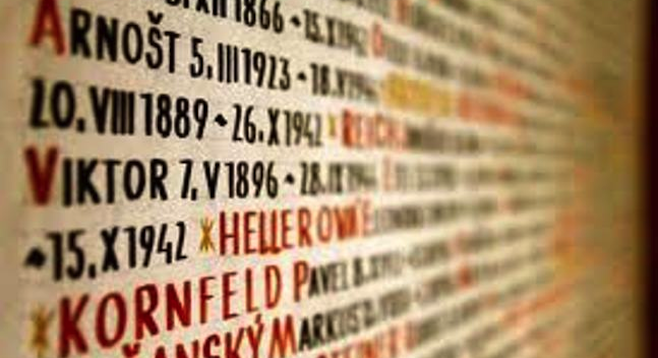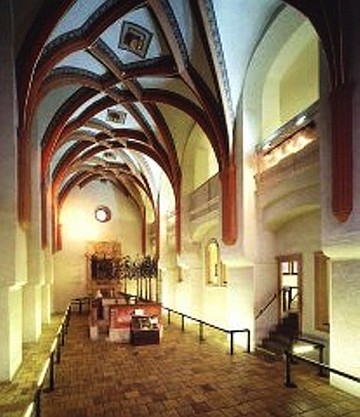 Facebook
Facebook
 X
X
 Instagram
Instagram
 TikTok
TikTok
 Youtube
Youtube

“Josefov.” The center of Jewish influence in Prague. A few other temples are scattered around the oldest part of the city, but Josefov is the vortex of Prague’s Jewish past.
It was this name of the Jewish quarter, a name stringing together letters sounding so remarkably Jewish, arranged on a street sign like any other, hanging on a building like any other – inconspicuous but startlingly familiar in this place so unlike home, that brought to me a shadow of earthly belonging. Of a place of Jews. A place where people like me live.
As an American, I have so many ancestral ties that I tend to get this feeling a lot – an Irish pub in Dublin, a rooftop in Jerusalem, Poet’s Corner in Westminster Abbey. Usually, I adore these places. I am drawn, lovingly, almost ethereally to these places. It is like being led inside from a new and sometimes discordant rain: the stepping stones of ancestors’ byways warm you, bring you back to yourself, and somehow restore stability through a kind of raw and sanguine strength.
But here I had procrastinated. This was the virtual first step of the Holocaust, and these are stones of horror as much as tribute to family past. I’m not big on horrors. Hiccups in life are one thing, and I do my best to avoid them. Horrors are not hiccups. For me it was a big step onto these stones, and my husband and I, although we never said why, had left this for last. We finally made it to the first temple within an hour of closing.
Surprisingly, there was a high security alert that day. When is there not a high security alert around a regularly visited Jewish site?

So we had to give our ID, and then we happily paid the entrance fee granting us access to centuries-old temples, museums and the infamous overcrowded graveyard. It was like paying a fee at any other attraction. There was the bored ticket-taker. The turnstiles. The poles designating the proper place to line up (had there been a line).
We took our tickets, glad to be contributing to restored old places, and went inside the first attraction.

And attractive it was. An old, high-ceiling temple with twists and turns through manicured arches and beautiful candlelight. There were writings on the walls – an instant joy for someone who covered her bedroom walls with quotes from artists like Whitman and Bono. There were words collected and arranged into beautiful phrases about life and loss. All before even the first arch. Before the first turn.
Through the first arch and around the turn, and we had fallen into a rabbit hole with the depth of death without leaving the ground. There was still the warm light, the beautiful ceilings, a welcoming, almost beckoning, resonance in the air. And there were the still beautifully collected inscriptions.
But here they virtually covered the room.
They were names: etched in red and printed just large enough to read. It was as if the designer had tried to list as many names as possible, because every last one was as real as the one before and the thousands to come, but there was only this limited space. They had to be big enough to read, big enough to be remembered, big enough to remind anyone who saw one that this person was not just ash dispersed into the skyline but a soul that had lived and breathed and meant someone to at least one other person.
A problem of space. A fight between giving a ghost her justice and the imposition of spatial limitation. Not an uncommon problem in the world.
These were the names of the lost people of Prague. The Jews at the center of the Nazi whirlwind who, it was likely, had actually been whirled away and turned to wind. Ground zero, I guess we might call it now. Names of people, real people, carefully inked in columns on the walls, listed by community and alphabetically to make them easy to find.
And find them we did. My husband’s family.
It became like a game, a surreal "Where’s Waldo" search as we went from wall to wall, room to room, arch to arch, looking at names from various communities. Here’s a Berman. I think it was Miriam. There’s another. I think it was Benjamin. And another. And another. And another. Until finally we had to leave if we were going to see anything else.
I stood under the last arch and looked at my husband. This tall, beautiful, jet-lagged man was seemingly undisturbed, more curious than anything else. Like he had been looking through an old family photo album of relatives he had never met.
I looked back at the red people living on the walls and had a sudden momentary feeling that his blood had been used as the ink. And then I thought how strange that was. And how upside-down, because it had been their blood that gave life to him, not the other way around. Not that they would ever know. But I know now. I know they gave him to me.
So I said a quiet thank-you, and passed through the arch.


“Josefov.” The center of Jewish influence in Prague. A few other temples are scattered around the oldest part of the city, but Josefov is the vortex of Prague’s Jewish past.
It was this name of the Jewish quarter, a name stringing together letters sounding so remarkably Jewish, arranged on a street sign like any other, hanging on a building like any other – inconspicuous but startlingly familiar in this place so unlike home, that brought to me a shadow of earthly belonging. Of a place of Jews. A place where people like me live.
As an American, I have so many ancestral ties that I tend to get this feeling a lot – an Irish pub in Dublin, a rooftop in Jerusalem, Poet’s Corner in Westminster Abbey. Usually, I adore these places. I am drawn, lovingly, almost ethereally to these places. It is like being led inside from a new and sometimes discordant rain: the stepping stones of ancestors’ byways warm you, bring you back to yourself, and somehow restore stability through a kind of raw and sanguine strength.
But here I had procrastinated. This was the virtual first step of the Holocaust, and these are stones of horror as much as tribute to family past. I’m not big on horrors. Hiccups in life are one thing, and I do my best to avoid them. Horrors are not hiccups. For me it was a big step onto these stones, and my husband and I, although we never said why, had left this for last. We finally made it to the first temple within an hour of closing.
Surprisingly, there was a high security alert that day. When is there not a high security alert around a regularly visited Jewish site?

So we had to give our ID, and then we happily paid the entrance fee granting us access to centuries-old temples, museums and the infamous overcrowded graveyard. It was like paying a fee at any other attraction. There was the bored ticket-taker. The turnstiles. The poles designating the proper place to line up (had there been a line).
We took our tickets, glad to be contributing to restored old places, and went inside the first attraction.

And attractive it was. An old, high-ceiling temple with twists and turns through manicured arches and beautiful candlelight. There were writings on the walls – an instant joy for someone who covered her bedroom walls with quotes from artists like Whitman and Bono. There were words collected and arranged into beautiful phrases about life and loss. All before even the first arch. Before the first turn.
Through the first arch and around the turn, and we had fallen into a rabbit hole with the depth of death without leaving the ground. There was still the warm light, the beautiful ceilings, a welcoming, almost beckoning, resonance in the air. And there were the still beautifully collected inscriptions.
But here they virtually covered the room.
They were names: etched in red and printed just large enough to read. It was as if the designer had tried to list as many names as possible, because every last one was as real as the one before and the thousands to come, but there was only this limited space. They had to be big enough to read, big enough to be remembered, big enough to remind anyone who saw one that this person was not just ash dispersed into the skyline but a soul that had lived and breathed and meant someone to at least one other person.
A problem of space. A fight between giving a ghost her justice and the imposition of spatial limitation. Not an uncommon problem in the world.
These were the names of the lost people of Prague. The Jews at the center of the Nazi whirlwind who, it was likely, had actually been whirled away and turned to wind. Ground zero, I guess we might call it now. Names of people, real people, carefully inked in columns on the walls, listed by community and alphabetically to make them easy to find.
And find them we did. My husband’s family.
It became like a game, a surreal "Where’s Waldo" search as we went from wall to wall, room to room, arch to arch, looking at names from various communities. Here’s a Berman. I think it was Miriam. There’s another. I think it was Benjamin. And another. And another. And another. Until finally we had to leave if we were going to see anything else.
I stood under the last arch and looked at my husband. This tall, beautiful, jet-lagged man was seemingly undisturbed, more curious than anything else. Like he had been looking through an old family photo album of relatives he had never met.
I looked back at the red people living on the walls and had a sudden momentary feeling that his blood had been used as the ink. And then I thought how strange that was. And how upside-down, because it had been their blood that gave life to him, not the other way around. Not that they would ever know. But I know now. I know they gave him to me.
So I said a quiet thank-you, and passed through the arch.
Comments